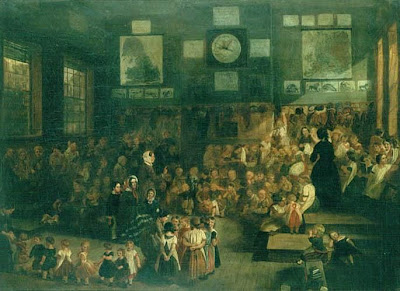Tour of Lost Birmingham Nᵒ.5: Birmingham's First Infant School (Ann Street, now Colmore Row)
~Oil painting of the interior of the school (1855) by Alfred H. Green. On the wall you can see maps, a very large clock, and coats hung up neatly on hooks. Several lessons are being conducted with different groups, some children are daydreaming, but most seem enthralled in their seperate activites. When the school first opened visitors were so numerous wanting to see the running of the school (which would have been a novelty) visiting times had to be restricted. Outside the rear of the building was a playground, and a house for the Master and Mistress was also built. ~
The story of Birmingham's first infant school began in August 1825 with the formation of Birmingham's Infant School Society. This group saw the benefits in forming an Infant School for the poorer classes, based on establishments already set up in London, and visited Spitalfields School to gain inspiration for their own venture. Although small scale schools had been run previously (as in the Sunday School rooms of St. Philip's), now a permanent site on Ann Street was chosen (near Harris's glass warehouse) and a design for the building drawn up by Thomas Rickman and Henry Hutchinson which was built by 1826.*
The undertaking was all part of the wider infant school movement of the 1820s which had grown out of the observation that many mothers of working class children were employed for long hours in the workshops and factories of many of the towns, leaving their children to fend for themselves. Joseph Corbett (born c. 1792), a man who worked his way up from humble beginnings, wrote of his own working mother;
She 'worked in a manufactory from a very early age. She was clever and industrious, and [...] was regarded as an excellent match for a working man. She was married early [and] became the mother of eleven children: I am the eldest. [...] She had children apace. As she recovered from her lying-in, so she went to work, the babe being brought to her at stated times to receive nourishment. As the family increased, so everything like comfort disappeared altogether. The power to make a home cheerful and comfortable was never given to her. [...] She made many efforts to obstain from shop work; but her pecuniary [monetary] necessities forced her back into the shop. [...] I have known her, after the close of a hard day's work, sit up nearly all night for several nights together washing and mending clothes. [...] [The] cold and hunger, and the innumerable sufferings of my childhood, crowd upon my mind and overpower me [...]'.
It was stories like this one that encouraged the wealthier to help these children that were affected by so many mothers needing to work. It was not all charity though, there was a fear factor involved as well, as Lynn Hollen Lees states; '[s]avage, uncontrolled children became central symbols of danger in the new urban, industrial society'.** Children were the next generation and their 'vices' would be passed down to the future (growing) generations, but so too could any virtues instilled in them. The school stated that it was proud of rescuing the children ‘from bad examples, and idle and vicious habits in the streets’, and providing ‘seminaries of early moral and religious instruction’.*
The school was run, like many infant schools across the country, by many members of the Society of Friends. Payment of 2d per week was required for attendance of the school, which took up to 200 children aged between two and six.* Lessons were often taught using pictures and letter frames, maths was also taught, but at this point, education was secondary; the Infant School Society itself stated ‘[t]he knowledge acquired by the children is, on its own account, comparatively of little importance, but the habits they acquire are invaluable’.* The school followed the published advise of the W. Wilson, vicar of Walthamstow, who had been writing on the subject of instruction in infant schools since at least 1825 (see external links, below).***
To raise funds in order to keep the school running, the Infant School Society had decided in 1825 to have an upper floor built to the premises and rent it out to the Lancastrian Girls School. There were probably two separate entrances for the two schools, the Infant School was at number 48 and the Ladies School above was classed as number 47. The lower floor was also rented out to Christ Church's Sunday School. By 1857 the Ladies School upstairs was still going strong, and was for the purpose of educating young working women who were employed for long hours, sometimes from 8am till 9 pm, in the manufatories. It offered morning classes, and to a lesser extent evening classes teaching reading, writing and household duties, geography was also introduced, and there was a decent collection of books on these subjects.* The school also organised days out to places such as Bewdley, this particular excursion planned and carried out by Charles and Mary Sturge, two of the school's supporters.*
NOTES
* References on request
** Lynn Hollen Lees, The Solidarities of Strangers: The English Poor Laws and the People, 1700-1848 (Cambridge University Press, 1998).
Books utilised.
Nanette Whitbread, The Evolution of the Nursery Infant School: A History and Nursery Education in Britain, 1800-1970 (London: Routledge and Kegan Paul Ltd, 1972).
External Links
***Book: A Manual of Instruction for Infant Schools by W. Wilson, click here.
To find out more click on the labels below.

